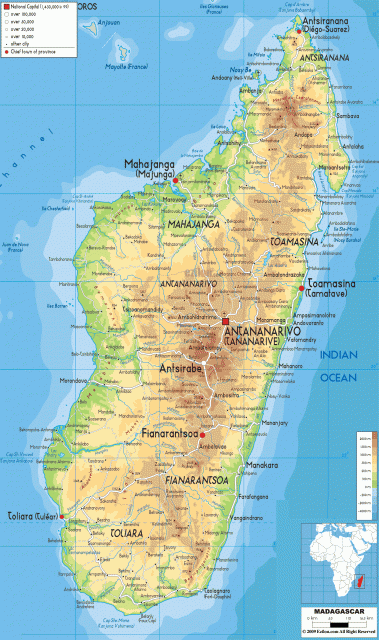Madagascar
Area 364,500 square mi (587,040 square km)
Population 23.57 million (2014)
Capital Antananarivo
Highest Point 9,435 ft (2,876 m)
Lowest Point 0 m
GDP $10.59 billion (2014)
Primary Natural Resources chromite, coal, bauxite, salt, quartz.
MADAGASCAR, THE WORLD'S fourth-largest island, after GREENLAND, New Guinea, and BORNEO, is located 250 mi (400 km) off the southeast coast of Africa. The climate is temperate, with average temperatures ranging between 48 degrees F (8 degrees C) and 81 degrees F (27 degrees C). The island coastal region is tropical with a rainy season that extends from November through April.

The island of Madagascar has been described as an “alternate world” or a “world apart” because of the uncommonness of many of its plant and animal species. Most life forms on the island have an African (or South American) origin. Millions of years of isolation have allowed old species, elsewhere extinct, to survive and new species unique to the island to evolve. A great number of plant, insect, reptile, and fish species are found only in Madagascar. Madagascar once was covered almost completely by forests but has been deforested by the practice of burning the woods to clear the land for dry rice cultivation. Wood and charcoal from the forests are used to meet 80 percent of domestic fuel needs. As a result, fuel wood is in short supply. Rainforests survive on the hillsides along a slender north-south border on the east coast. Secondary growth, which has replaced the original forest and consists to a large extent of traveler's trees, raffia, and baobabs, is found in many places along the east coast and in the north.
The landscape of the central highlands and the west coast is savanna or STEPPE, and coarse prairie grasses grow where erosion has not taken over. The remaining rainforest contains a great number of unique plant species. The country has some 900 species of orchids. Banana, mango, coconut, vanilla, and other tropical plants grow on the coasts, and the eucalyptus tree, brought from Australia, is prevalent.
Madagascar was once an independent kingdom but became a French colony in 1896. It regained its independence in 1960. The current system of government is a that of a republic. A constitution was adopted through a referendum vote on August 19, 1992, and free elections were held in 1992 and 1993, ending 17 years of single-party government. Madagascar's independence encouraged the practice of economic privatization and liberalization. This strategy has placed the country on a slow and steady growth path from a 71 percent poverty level.
Agriculture, including fishing and forestry, is the driving economic force of the economy, accounting for more than one-quarter of gross domestic product and employing four-fifths of the population. Other predominant industries on Madagascar are meat processing, soap making, breweries, tanneries, sugar, textiles, glassware, cement, an automobile assembly plant, paper, petroleum, and tourism. The primary agriculture products are coffee, vanilla, sugarcane, cloves, cocoa, rice, cassava (tapioca), beans, bananas, peanuts, and livestock.
The official languages are Malagasy and French although additional regional dialects are spoken. More than half the population follows Animist beliefs (Animism founded upon the belief that the things around us are infused with more than mere existence. Animists believe that the hills, valleys, waterways, and rocks are spiritual beings, as are the plants and animals.) Christianity is practiced by about 43 percent of the population with the remaining being Muslim. There are approximately 20 ethnic groups that make up the population of Madagascar: the central highlanders (Merina and related Betsileo) and cotiers of mixed Arab descent, African, Malayo-Indonesian, Comoran, French, Indo-Pakistani, and Chinese. The life expectancy is 56.54 years of age.